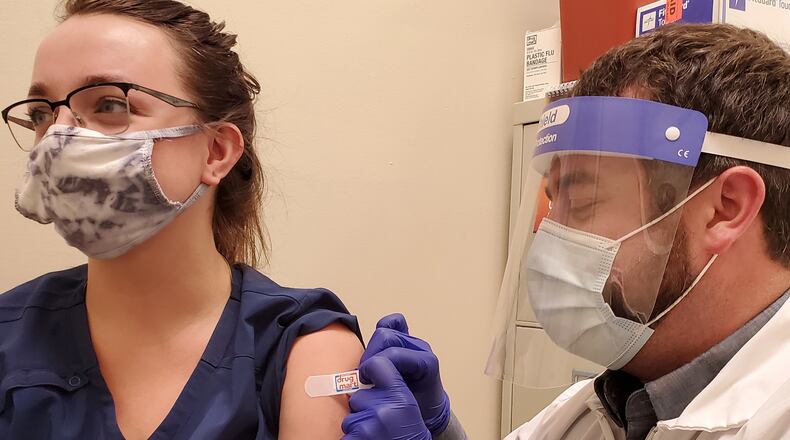“I’ve always recommended flu shots starting the beginning of October, but this year I would just push people to start getting their flu shots now,” said Dr. Glen Solomon, chair of internal medicine and neurology at Wright State University Boonshoft School of Medicine.
Significant spread of multiple respiratory viruses means challenges in identifying what illness a person has. While people with the flu should stay home if sick, people infectious with the highly contagious new coronavirus should isolate, their recent close contacts should be alerted and quarantine, and any medical providers that treat them should be properly outfitted with personal protective equipment.
Solomon said COVID-19 can have some symptoms that don’t come with flu, such as that some patients temporarily lose their sense of taste and smell.
“But it’s going to be difficult for people to separate out what they have,” Solomon.
He said measures to prevent COVID-19 like keeping distance and wearing masks also reduce the risk of flu.
“The things we’re doing to prevent the one will help prevent the other,” he said.
The flu season can also take up lots of hospital capacity, including last year when flu cases pushed the Miami Valley Hospital emergency department to capacity. If flu and COVID-19 cases both surge at the same time, that could strain hospital staff, beds and supplies as they work to care for all patients.
Sarah Hackenbracht, CEO of the Greater Dayton Area Hospital Association, said hospitals in the region have been working on plans for this flu season.
“Everything from vaccinations, to the management of PPE, to protecting employees and protecting patients -- they are looking at the entire continuum, along with educating community providers and partners about the symptoms of flu and COVID-19 to help align what will need to happen from a testing perspective,” Hackenbracht said.
Some people are at higher risk of developing serious flu-related complications if they get sick, such as people 65 years and older; people of any age with certain chronic medical conditions, such as asthma, diabetes, or heart disease; pregnant women, and children younger than 5 years.
On average 83% of Ohio short-stay nursing home residents and 96% of long-stay nursing home residents get the flu shot. You can call a nursing home to learn about resident options for getting a flu vaccine and look up a facility’s recent flu vaccination rates at medicare.gov/nursinghomecompare by searching for a particular facility and then clicking on their “Quality of Care” metrics.
Flu vaccines have been recently arriving in the area. Jason Briscoe, Discount Drug Mart director of pharmacy operations, said they have received flu vaccines at all locations, have been vaccinating patients.
“We have seen a significant increase in flu and other important immunizations compared to the same time last year," Briscoe said.
Flu vaccines are expected to arrive soon at the Public Health - Dayton & Montgomery County vaccination clinic.
Planned Parenthood Southwest Ohio has not offered flu shots in previous years, but in light of the pandemic and because it is the only health care provider for some of its patients, staff are trying to get an inventory of the vaccine for its four family planning centers.
“ We understand the importance of accessing care and are committed to ensuring our patients and surrounding communities remain healthy during this difficult time,” Vice President of Patient Services Katie Brokesh said in a statement.
Flu vaccine uptake varies, remains low
According to national health objectives, the goal is to vaccinate at least 70% of the population six months and older.
Despite recommendations and being fully covered as a preventive service under the Affordable Care Act, Kaiser Family Foundation says the overall flu vaccination rate remains low and there are persistent racial and ethnic disparities in uptake of the vaccine among adults.
During the 2018-2019 flu season, less than four in 10 Black (39%), Hispanic (37%), and American Indian and Alaska Native (38%) adults were vaccinated compared to 49% of white non-Hispanic adults. The rates for children of color were generally at least equal to white children in the U.S.
According to the foundation, this is associated with disparities in uninsured rates and people of color are more likely be uninsured and less likely to have a usual source of care. Across racial and ethnic groups, uninsured adults were less likely to be vaccinated compared to those with private coverage. Vaccination rates among adults with Medicaid coverage were similar to those with private coverage across most groups.
How to find a flu vaccine
Many pharmacies, primary care practices and workplaces offer flu vaccines. Vaccinefinder.org can help you search for options.
About the Author
